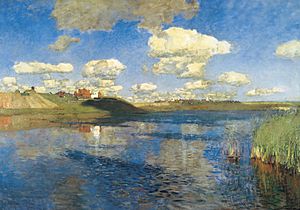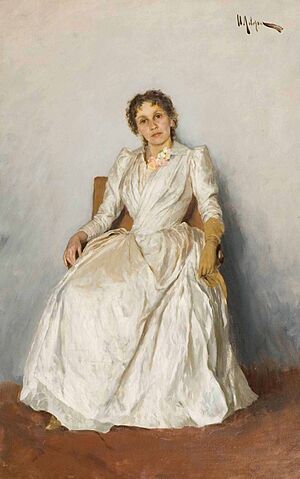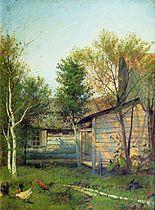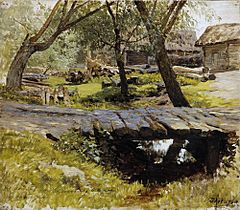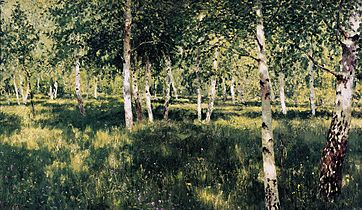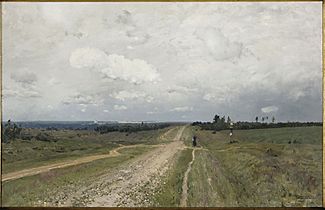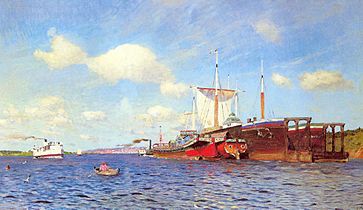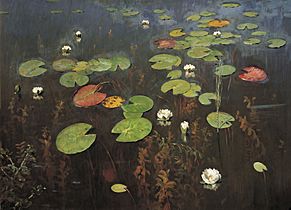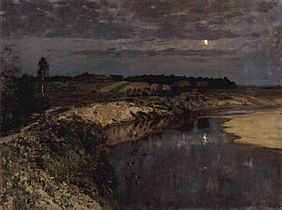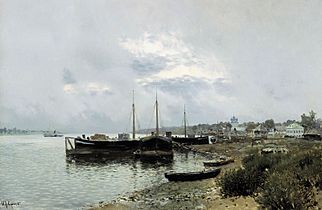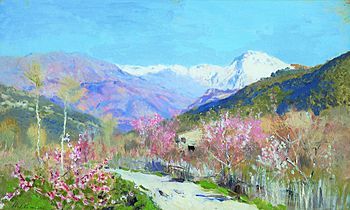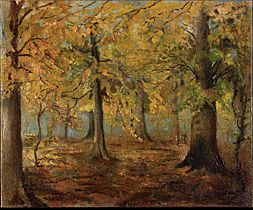Isaac Levitan facts for kids
Quick facts for kids
Isaac Levitan
|
|
|---|---|

Issac Levitan, Self portrait (1880)
|
|
| Born |
Isaac Ilyich Levitan
30 August [O.S. 18 August] 1860 Kibarty, Augustów Governorate, Congress Poland, Russian Empire
|
| Died | 4 August [O.S. 22 July] 1900 (aged 39) |
| Nationality | Russian |
| Education | Member Academy of Arts (1898) |
| Known for | Painting |
|
Notable work
|
Autumn day. Sokolniki (1879) Over Eternal Peace (1894) |
| Movement | Realism, Peredvizhniki, Impressionism |
| Awards | Silver Medal (1877) |
| Patron(s) | Pavel Tretyakov, Savva Mamontov |
Isaac Ilyich Levitan (Russian: Исаа́к Ильи́ч Левита́н; August 30, 1860 – August 4, 1900) was a famous Russian landscape painter. He became known for creating "mood landscapes," which are paintings that show feelings and emotions through nature.
Contents
Life and Work
Early Life
Isaac Levitan was born in a small town called Kibarty. This town was in what is now Lithuania, but at the time it was part of the Russian Empire. His family was Jewish and didn't have much money, but they valued learning. His father, Elyashiv Levitan, was a rabbi's son who taught himself many things. He worked as a teacher and later as a translator for a French company building a railway bridge.
In the early 1870s, Levitan's family moved to Moscow. In September 1873, Isaac started studying at the Moscow School of Painting, Sculpture and Architecture, often called the Moscow School of Art. His older brother, Avel, was already studying there. After a year, Isaac moved into the landscape painting class. His teachers included famous artists like Alexei Savrasov, Vasily Perov, and Vasily Polenov. In 1875, Nikolai Chekhov, the brother of the famous writer Anton Chekhov, also joined the school. Nikolai later became one of Levitan's closest friends.
In 1875, Levitan's mother died. His father then became very sick and could not support his four children. His father died in 1877, leaving the family very poor. Because of Levitan's great talent and to help him stay in school, he was given a scholarship.
Becoming a Painter
In 1877, Isaac Levitan's paintings were shown to the public for the first time. People liked his work a lot. In 1879, after a difficult time when many Jewish families had to leave big cities, Levitan was allowed to return to Moscow.
That year, he painted Autumn day. Sokolniki. This painting showed a long path in a Moscow park. When his friend Nikolai Chekhov saw it, he suggested that the path needed someone walking on it. So, Chekhov painted a woman in a black dress walking in the picture. Artists often worked together like this. In 1880, a famous art collector named Pavel Mikhailovich Tretyakov bought the painting. Tretyakov continued to buy many of Levitan's works, eventually owning more than 20 of his paintings.
Levitan's teacher, Savrasov, taught him to paint outdoors, which is called en plein air. Before this, many thought the Russian countryside was not interesting enough to paint. But for Levitan, landscapes became the most important part of his art. Savrasov taught him to paint small details and to put his feelings into his works.
By 1883, Levitan was not happy with the Moscow School of Art. He hoped to win a silver medal for a landscape painting, which would make him a recognized artist. However, the school rejected his painting. Some people believe this was because of unfair opinions about him being Jewish. Despite this, Levitan stopped attending classes.
In 1884, Levitan joined the Peredvizhniki, a group of artists who held traveling art exhibitions to show their work to more people. He became a full member in 1891. During his time at the Moscow School of Art, Levitan became friends with other artists like Konstantin Korovin and Mikhail Nesterov. He often visited the Chekhov family, and some people think he was in love with Anton Chekhov's sister, Maria.
In the early 1880s, Levitan worked with the Chekhov brothers on a magazine and illustrated a book about the Kremlin. From 1885 to 1886, he and Korovin painted scenery for operas. One time, the audience applauded when the curtain rose for an underwater scene Levitan helped paint for the opera Rusalka.
Friendship with Anton Chekhov
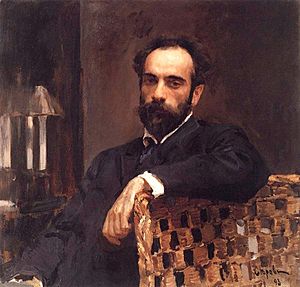
By the mid-1880s, Levitan and Anton Chekhov became very close friends. Levitan often spent time with the Chekhov family at their home near Babkino. During one summer there, he painted The River Istra (1885) and gave it to Chekhov. He also painted Twilight River Istra (1885), which used darker colors.
In 1892, Levitan and Chekhov had a disagreement. Chekhov published a story called The Grasshopper, and Levitan believed it was based on his personal life. Even though Chekhov apologized, they did not speak for a few years, until January 1895.
Painting Moods of Nature
Levitan's paintings showed a deep love for the beauty of the Russian landscape. He usually did not paint cities. Instead, he focused on the countryside, forests, and quiet places. He became known for his "mood landscapes," where the natural scene reflects human feelings. His paintings often have a quiet, thoughtful, and sometimes a little sad feeling, with few or no people in them. Good examples of this style are Vladimirka (1892), Evening Bells (1892), and Eternal Rest (1894). These are all in the Tretyakov Gallery.
Levitan's later works showed some influence from Impressionism, but his colors were usually softer. He focused more on showing nature as it truly was, but with a poetic touch, rather than just focusing on light and color like Impressionists.
Birch trees, which are common in Russia and symbolize spring, were a favorite subject for Levitan. He painted them in different seasons. In Spring Flood (1897), you can see the thin white trunks of birches reflected in the water left by melting snow. Birch Grove (1885–89) is another spring scene, painted with an Impressionist style, showing sunlight filtering through the trees. Golden Autumn (1895) shows a group of autumn birches with bright orange and yellow leaves under a cloudy sky. The sky is reflected in a dark blue river. Levitan painted not just the trees, but also how the light shone on them. This is clear in Moonlit Night: Main Road (1897), where two rows of birches glow in the moonlight along a straight road.
Later Years
In the summer of 1890, Levitan visited Yuryevets and painted many landscapes. One of these led to his famous painting, The Silent Monastery. This painting of a quiet monastery and bridges connecting it to the outside world showed his deep thoughts. This picture made a strong impression on Chekhov.
By 1891, Levitan was a member of the Peredvizhniki group. While many artists in this group wanted to show the difficult lives of Russian people, Levitan simply wanted to paint beauty. He also showed his art with the World of Art group, a younger generation of artists who believed that beauty was the main goal of art.
In September 1892, Jewish people were again forced to leave Moscow, and Levitan left for Boldino. His friends helped him return to the city by December of that year.
In 1897, Levitan was already famous around the world. He was chosen to join the Imperial Academy of Arts. In 1898, he became the head of the Landscape Studio at his old school, the Moscow School of Art.
Levitan spent the last year of his life at Chekhov's home in Crimea. He suffered from a heart condition for most of his life, but his last paintings are full of light and show the peaceful, lasting beauty of Russian nature.
Isaac Levitan was buried in the Dorogomilovo Jewish cemetery. In 1941, his remains were moved to the Novodevichy Cemetery, near where Chekhov was buried. Levitan did not have a family or children.
Isaac Levitan left behind a huge collection of art, with over a thousand paintings, including watercolors, pastels, and illustrations.
Legacy
The year after Levitan died, an exhibition of hundreds of his paintings was shown in Moscow and then in St. Petersburg. His works appeared on the covers of Russian textbooks, and schoolchildren learned about his love for his home country through his art.
A minor planet called 3566 Levitan, discovered in 1979, is named after him.
Gallery
See also
 In Spanish: Isaak Levitán para niños
In Spanish: Isaak Levitán para niños
- List of Russian artists



